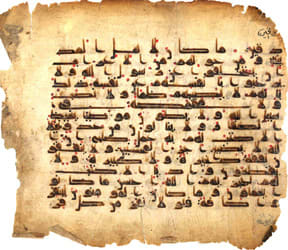Qur'an Leaf in Kufic Script, 700 CE - 900 CE
Ink on Parchment
PF.6323
Calligraphy has never been challenged as the supreme art of the Islamic world, reflecting the centrality of the Qur’anic revelation to Islamic faith and culture. In Islam, the Qur’an is...
Calligraphy has never been challenged as the supreme art of the Islamic world, reflecting the centrality of the Qur’anic revelation to Islamic faith and culture. In Islam, the Qur’an is held to be God’s actual revelation. The establishment of the “Abbasid Caliphate (750-1258), with its capital in Baghdad, marked a new stage in the cultural and economic integration of the Mediterranean and Asia. Among the new cultural forms that emerged in the cosmopolitan early ‘Abbasid period were illuminated Qur’ans in horizontal format, written in angular scripts frequently called “Kufic”, after the city of Kufa in Iraq; where the style is said to have originated. The crisp elegance of many of these scripts and the luxurious sophistication of illumination in the first centuries of the ‘Abbasid period have contributed to the notion that this was a “classical” age in the Qur’an production. The diffusion of Kufic styles throughout the Near East and the Mediterranean is visual testimony to the Dynasty, which stretched at its height from the Atlantic to the borders of China.
This is a folio from an Arabic Manuscript written in the Kufic script in brown in on parchment with fifteen lines on the page. The vocalization (probably added later) is applied using red and green dots, with some pale pinkish dots, which may be oxidized, or faded browny-yellow. Original single verse divisions are marked with vertical rows of one, two or three dashes.
Here, the calligrapher has obviously achieved a monumental effect on considerable beauty. (LK)
References:
Fraser, Marcus and Kwiatkowski, Will, Ink and Gold: Islamic Calligraphy, 200
This is a folio from an Arabic Manuscript written in the Kufic script in brown in on parchment with fifteen lines on the page. The vocalization (probably added later) is applied using red and green dots, with some pale pinkish dots, which may be oxidized, or faded browny-yellow. Original single verse divisions are marked with vertical rows of one, two or three dashes.
Here, the calligrapher has obviously achieved a monumental effect on considerable beauty. (LK)
References:
Fraser, Marcus and Kwiatkowski, Will, Ink and Gold: Islamic Calligraphy, 200
